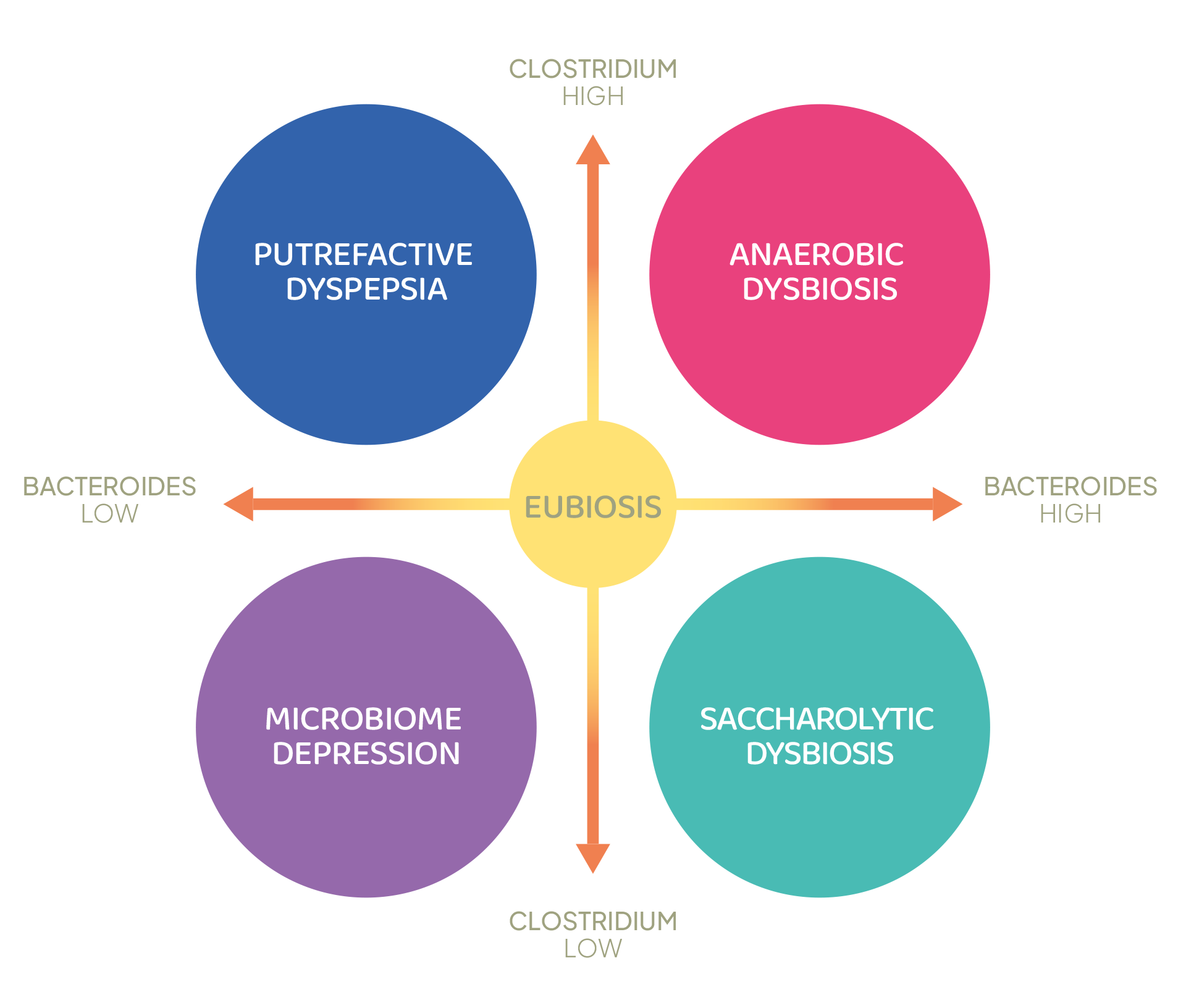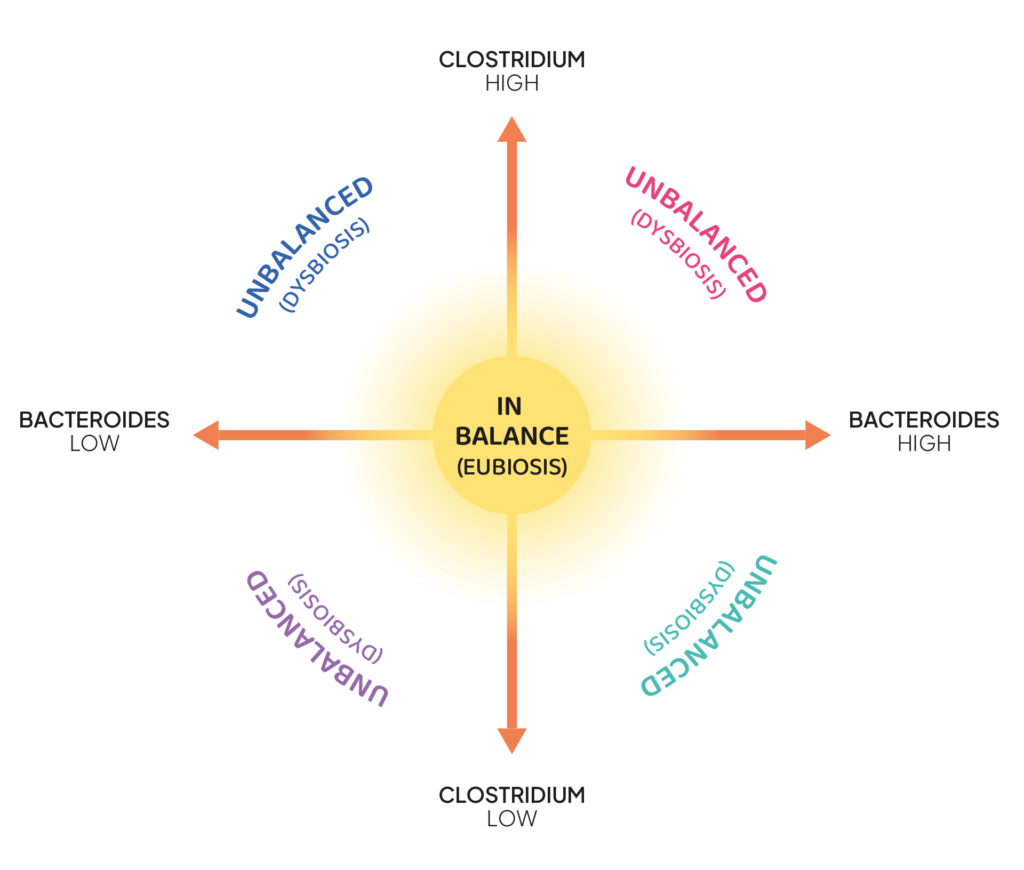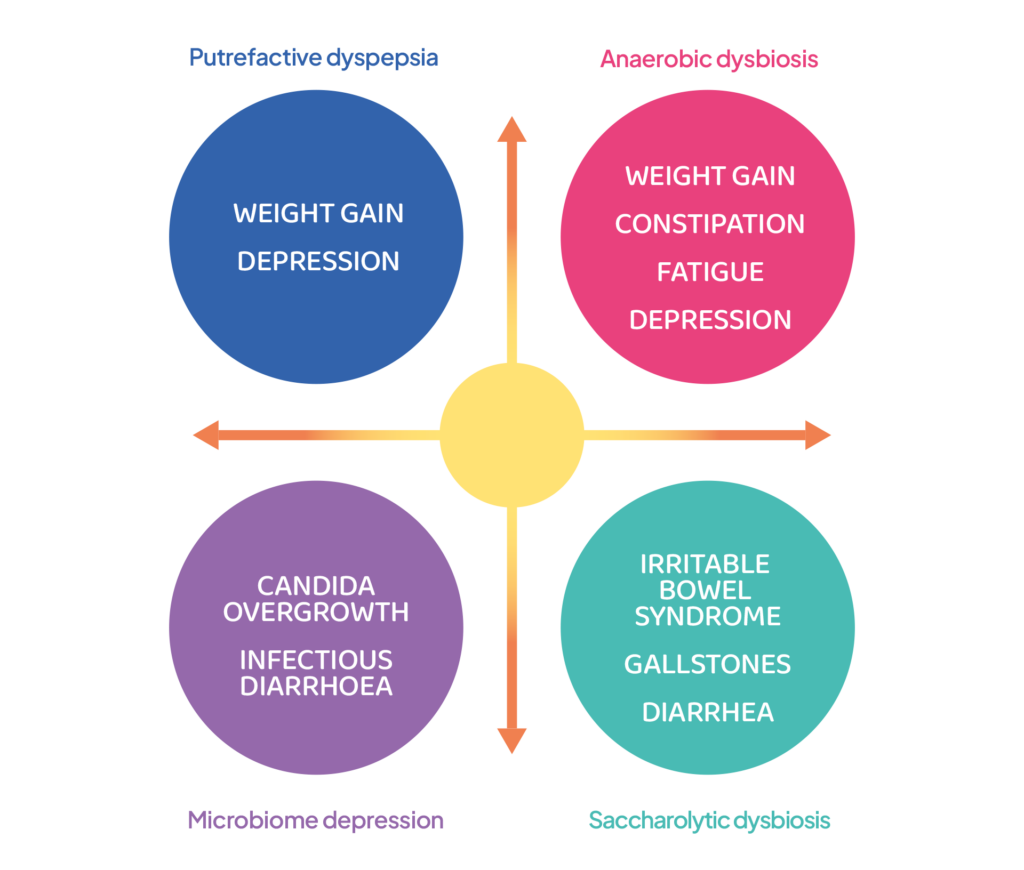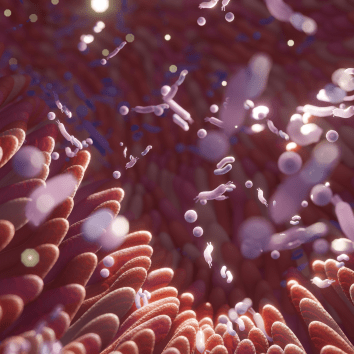Our improved model for dysbiosis of the gut microbiome

In our view, the classical dysbiosis model is too limited and outdated, because it works with only two different states: in balance (eubiosis) and out of balance (dysbiosis). We have therefore developed a more comprehensive and therefore more specific model. Our model has four different basic types, each of which has its own characteristics and requires its own approach. This provides the practitioner with a very useful and affordable diagnostic tool.
By Dr. Gijsbert J. Jansen, microbiologist at NL-Lab
What is Dysbiosis?
A dysbiosis is a disturbance of a microbiome. If the situation is not dysregulated, it is referred to as eubiosis. In practice, the term eubiosis is little used and the term dysbiosis is mainly associated with a disruption of the microbiological composition of the colon. So when we talk about dysbiosis, we mean imbalance of the gut microbiome.
Nowadays, the relationship between dysbiosis and various diseases is well known and part of the medical-scientific literature [1].
The two main bacterial groups in the gut microbiome
The gut microbiome is a very complex ecosystem composed mainly of vast amounts of bacteria. These can be divided into several groups. The two main groups are the Bacteroides and Clostridium.
The gut microbiome of an adult with a Western diet consists of about 80% of these two bacterial groups[2]. Abnormalities in the numbers and/or activity of these bacterial groups therefore determine the overall stability of the gut microbiome. For this reason, these groups form the basis for our dysbiosis model.
Four basic types of dysbiosis
Since these groups can be both increased and decreased, a total of four types of dysbiosis are conceivable (Figures 1-2).
- Putrefactive dyspepsia (Clostridium high, Bacteroides low)
- Anaerobic dysbiosis (Clostridium high, Bacteroides high)
- Microbiome depression (Clostridium low, Bacteroides low)
- Saccharolytic dysbiosis (Clostridium low, Bacteroides high)
If one of the two bacterial groups deviates one speaks of a partial dysbiosis. The effect of a partial dysbiosis is generally less drastic than a complete dysbiosis, in which the numbers of both the Clostridia and Bacteroides are abnormal.
The type of dysbiosis is an initial and important indicator for understanding the status of the gut microbiome

Figure 1: Microbiome plot describing >80% of the gut microbiome

Figure 2: Definition of the four basic types of dysbiosis
Relationship between dysbiosis and disorders
There are a number of direct physiological explanations for the dysbiotic type and associated symptoms.
Figure 3 gives an indication of the possible health risks to which a patient is exposed in the occurrence of one of the four possible types of dysbiosis. Of course, the pathologies mentioned have multiple causes beyond the dysbiotic status of the gut microbiome.

Figure 3: Symptom patterns associated with the four basic types of dysbiosis
Below, for each dysbiotic situation, a brief explanation of cause and effect will be given.
Putrefactive dyspepsia
This is a dysbiotic situation in which the numbers of Clostridium species predominate in the microbiome. This type of dysbiosis is often associated with a typical Western diet with a relatively high proportion of fat and animal protein. The production of various neurotoxins also results in depressive states and apathy [4]. As a result of the resulting reduction in physical activity, various secondary complaints may occur.
Anaerobic dysbiosis
This situation is a result of constipation. The intestinal contents come to a standstill and the aerobic bacteria present 'respire' the oxygen present until it is consumed. Then they die by hypoxia ('suffocation'), the situation in the gut is now completely anaerobic and the common anaerobes, including Bacteroides and Clostridia, further increase both in numbers and microbial activity. The Clostridia break down protein and fat from food into neurotoxins, among other things, which can cause symptoms such as fatigue, loss of concentration and depression . The slowed passage rate allows the intestine more time to absorb fat before this fat interacts with the Clostridia in the colon. This can lead to weight gain.
Microbiome depression
This situation is a consequence of an excessive intestinal passage rate. The reason for this increase can be multifactorial (use of an antibiotic is a common reason), but the consequences are fairly unambiguous: because large areas of the intestinal ecosystem are now "uninhabited," pathogens from the outside world, via the oral route, can easily colonize the intestinal system. Well-known examples are fungi and yeasts, such as Candida species. There is also the possibility that pathogens can enter the intestinal tract (through food, for example) and subsequently cause infection. These include Clostridioides difficile, Salmonella and Shigella species, and Listeria monocytogenes.
Saccharolytic dysbiosis
This is a dysbiotic situation in which the numbers of Bacteroides species predominate in the microbiome. The number of Clostridia is usually reduced. As a result, Fusobacteria in particular (derived from the oral microbiome) can settle in the gut. This is an undesirable situation since prolonged presence of oral bacteria in the gut can lead to polyps and tissue new formation.
A second consequence of this type of dysbiosis is the outgrowth of Prevotella species. These species are often responsible for infectious colitis, Small Intestinal Bowel Overgrowth (SIBO) and arthritis. The (reduced numbers of) Clostridia produce enzymes that have pathological significance. One example is decreased 7α-dehydroxylating activity in the intestine, which greatly increases the risk of gallstones [5].
How can you find out the type of dysbiosis?
When dysbiosis of the gut microbiome is suspected, an unequivocal diagnosis can only be made on the basis of stool testing. Traditional testing will only be able to provide you with a dysbiosis index, leaving it unknown what type of dysbiosis you are dealing with.
The Pro Dysbiosis Package for practitioners does give you all the diagnostic information you need. In addition to the test results, you get practical therapeutic advice tailored to the type of dysbiosis. A direct result of this is that the chances of therapeutic success will increase significantly. And all at a very affordable price.
Individuals can use the Balance package in the webshop to gain insight into the type of dysbiosis.
Are you an individual and interested in the Pro Dysbiosis package? You can contact us and we will send you some options of practitioners who offer this package.

Interested? Sign up!
The Pro Dysbiosis package can only be ordered by practitioners registered with us. After the no-obligation registration, we will provide you with all relevant materials, including price lists.
References
- de Filippis, A., Ullah, H., Baldi, A., Dacrema, M., Esposito, C., Garzarella, E. U., Santarcangelo, C., Tantipongpiradet, A., & Daglia, M. (2020). Gastrointestinal Disorders and Metabolic Syndrome: Dysbiosis as a Key Link and Common Bioactive Dietary Components Useful for their Treatment. International Journal of Molecular Sciences, 21(14), 4929. https://doi.org/10.3390/ijms21144929
- Gacesa, R., Kurilshikov, A., Vich Vila, A., Sinha, T., Klaassen, M. A. Y., Bolte, L. A., Andreu-Sánchez, S., Chen, L., Collij, V., Hu, S., Dekens, J. A. M., Lenters, V. C., Björk, J. R., Swarte, J. C., Swertz, M. A., Jansen, B. H., Gelderloos-Arends, J., Jankipersadsing, S., Hofker, M., ... Weersma, R. K. (2022). Environmental factors shaping the gut microbiome in a Dutch population. Nature, 604(7907), 732-739. https://doi.org/10.1038/s41586-022-04567-7
- de Vos, P., Garrity, G., & Jones, D. (2009). Systematic Bacteriology Second Edition Volume Three The Firmicutes: Vol. 3 Firmicutes (M. Goodfellow, P. Kampfer, P. de Vos, & F. Rainey, Eds.; 2nd ed.).
- Amirkhanzadeh Barandouzi, Z., Starkweather, A. R., Henderson, W. A., Gyamfi, A., & Cong, X. S. (2020). Altered composition of gut microbiota in depression: A systematic review. In Frontiers in Psychiatry (Vol. 11, pp. 1-10). Frontiers Media S.A. https://doi. org/10.3389/fpsyt.2020.00541
- Wang, Q., Hao, C., Yao, W., Zhu, D., Lu, H., Li, L., Ma, B., Sun, B., Xue, D., & Zhang, W. (2020). Intestinal flora imbalance affects bile acid metabolism and is associated with gallstone formation. BMC Gastroenterology, 20(1), 59.
An earlier version of this article was published on the Natuurdietisten.nl website
Sharing:
Also read...


The time between the collection of a (stool) sample and its processing in a laboratory has a...


